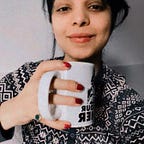autumn in museums
London, with all its galleries and museums, is full of departed friends for me. I have spent countless hours in front of artworks, trying to understand what the artist was thinking at that moment, what they wished to convey to me with their work. There’s a moment and a story left to be unpacked even in the most figurative and representational of paintings and sculptures. Unsurprisingly it’s the abstract in art that holds the most questions, where every stroke has been placed intentionally and yet comprehending them is often a trip down my own consciousness and understanding of the world.
My close proximity to South Kensington has meant that I am now a regular at the Victoria and Albert Museum, whiling away the weekend afternoons staring at ironwork and statues. I was quite familiar with the Islamic art and architecture section, and I’d been to the South Asian galleries enough times previously, so I decided to venture to the East Asian side of the museum two months ago. The vast room on Japan was expectedly busy, carmine paint and kimonos attracting crowds of anime and Murakami fans alike.
London reads a lot of Murakami, I realised one day on the way back home from work. I’d come across five different people with copies of Kafka on the Shore, 1Q84, and Norwegian Wood. I couldn’t remember if I had ever seen this many readers of Murakami in any of the other cities I’d lived in. My mother remarked on London’s voracious appetite for reading. “People read a lot here, I see young people reading in the park all the time”. She used the word অল্পবয়সী — the young. The park she was talking about was Highbury Fields, up in north London. She was right, people read their books on the benches in the park whenever the weather was pleasant. I used to read books there when it was bright out.
Once you exit the gallery hosting the Japan collection at the V&A, you enter the gallery with a collection of Chinese art. There are some magnificent pieces in this room, everything from Ming dynasty vases, to eighteenth-century snuff boxes, porcelain tea bowls, and more. Until recently, this is how far I had ventured on this floor of the museum. I always either ran out of time or got distracted by the prospect of seeing the Raphael Cartoons again. So in October, I decided to go further into the corridors and came across Room 47G. This was a narrow lane, a slip of a collection, with objects far fewer in number than what I just saw for Japan and China. Room 47G houses objects from the Korean peninsula, so I was intrigued by the prospect of perhaps finding a Dansaekhwa painting or two. I had no luck there. But what I did find at the very end of the room was a moon jar, encased in glass. I’d never seen a moon jar in person before. I’m sure there are a few at the British Museum, but going through rooms there is exhausting — the crowds are always more hectic to navigate.
This is a video showing how a moon jar is made. I watch this quite frequently.
It’s almost lopsided, the moon jar. You can see the marks from where the top and bottom were joined to form the jar. Its pristine white is marked with deliberately left patches. I have no doubt that masterful artists can perfect their moon jars. I have learned that imperfection is deliberate, a peaceful acceptance of the situation that you’re in, rather than striving towards an elusive perfection. It fits the ideals of Korean art as I’ve understood it. The moon jar at the V&A, made by Park Young Sook (박영숙) is currently my favourite piece in there. I find it fascinating, soothing, and peaceful — all at the same time.
My hunt for Dansaekhwa paintings continues in this city. I am certain that Tate Modern has a couple in their collection, but they’re probably not on display. I wish Burnt Umber & Ultramarine Blue was on display. I wish I could find Yun Hyong-Keun and Kim Whanki in this city which has everything. I’ll look harder.
